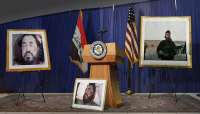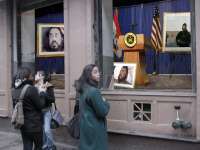Nicholas Knight Framing al-Zarqawi, 2006 Mixed media installation, including framed photographs, podium, US and Iraqi flags, rugs, easels, curtain, furniture, etc. Size determined by installation [never realized]
In June 2006, US-led forces in Iraq killed al-Qaeda leader Abu Musab al-Zarqawi, dropping two 500-lb bombs on the house in Baqubah where he was meeting with other insurgent leaders. Al-Zarqawi had been responsible for many of the most vicious attacks against American and Iraqi targets, and his death was heralded as a positive development during the bloody summer of 2006.
In Baghdad the next day, the Department of Defense held a press conference to announce the news. The assembled press corps was presented with a detailed narrative of the intelligence effort that led the American F-16s to al-Zarqawi’s location north of Baghdad. The journalists were also shown three large photographs of al-Zarqawi: one in which he was seen from the waist up, facing the camera, holding a machine gun; another showed his mortally wounded face, frontally, dead; the third was another death shot, this time in three-quarters view. Each of these photographs was placed on an easel so that the cameras in the room could get clear views. The intent was to allow the press corps to distribute the images back to their home bureaus, but also to use the media networks to inform the insurgency in Iraq that their leader had been killed. The visuals needed to be clear to combat any rumors that might surface that this was some sort of hoax, that al-Zarqawi was still alive.
The control of information and images, the distribution of propaganda, and the relationship between the government and the press are difficult issues to balance in a democracy during wartime. But one detail of this press conference struck me as having a particularly surreal bearing on these issues: the three photographs were shown to the press as enlargements framed with detailed gold molding. Suddenly I wanted to know what conversations and decisions had taken place behind the scenes in preparation for this press conference. Had there been some debate about which gold molding is the best for presenting photographs of slain terrorists? Do they have a frame shop at DoD headquarters in Baghdad? Who printed the enlargements of the photographs, and on what equipment? What became of the framed prints afterwards?
Since 2004 I have been developing a body of work, “Frame & Photo”, that considers the frame as the liminal bridge between the pictorial space of the photograph and the real space of the viewer. The works are analytical and philosophical, and any politics they may have operate well below the surface. My goal with this proposal for Art In General is not to create a screeching polemic. My goal is to highlight the peculiar functions of aesthetics during a politically fraught time.
I propose to create a diorama of this Baghdad press conference in the Project Space windows at street level. From the street the viewer will see the dais, the backdrop curtains, the podium, and the Oriental rug. And in the midst of this setting will be the easels and the three framed photographs of al-Zarqawi.
I do not wish to state a position about what this “means,” nor do I believe that the facts of the matter “speak for themselves.” However, I do believe that even the most rarefied of philosophical speculations can suddenly penetrate the real world with disruptive force. As an artist, a consumer of information, and a citizen, I want this proposal to dramatize one such historical moment, when aesthetic rupture occurred in full public view.
Nicholas Knight New York City February 23, 2009
Nicholas Knight Framing al-Zarqawi, 2006 Mixed media installation, including framed photographs, podium, US and Iraqi flags, rugs, easels, curtain, furniture, etc. Size determined by installation [never realized]
In June 2006, US-led forces in Iraq killed al-Qaeda leader Abu Musab al-Zarqawi, dropping two 500-lb bombs on the house in Baqubah where he was meeting with other insurgent leaders. Al-Zarqawi had been responsible for many of the most vicious attacks against American and Iraqi targets, and his death was heralded as a positive development during the bloody summer of 2006.
In Baghdad the next day, the Department of Defense held a press conference to announce the news. The assembled press corps was presented with a detailed narrative of the intelligence effort that led the American F-16s to al-Zarqawi’s location north of Baghdad. The journalists were also shown three large photographs of al-Zarqawi: one in which he was seen from the waist up, facing the camera, holding a machine gun; another showed his mortally wounded face, frontally, dead; the third was another death shot, this time in three-quarters view. Each of these photographs was placed on an easel so that the cameras in the room could get clear views. The intent was to allow the press corps to distribute the images back to their home bureaus, but also to use the media networks to inform the insurgency in Iraq that their leader had been killed. The visuals needed to be clear to combat any rumors that might surface that this was some sort of hoax, that al-Zarqawi was still alive.
The control of information and images, the distribution of propaganda, and the relationship between the government and the press are difficult issues to balance in a democracy during wartime. But one detail of this press conference struck me as having a particularly surreal bearing on these issues: the three photographs were shown to the press as enlargements framed with detailed gold molding. Suddenly I wanted to know what conversations and decisions had taken place behind the scenes in preparation for this press conference. Had there been some debate about which gold molding is the best for presenting photographs of slain terrorists? Do they have a frame shop at DoD headquarters in Baghdad? Who printed the enlargements of the photographs, and on what equipment? What became of the framed prints afterwards?
Since 2004 I have been developing a body of work, “Frame & Photo”, that considers the frame as the liminal bridge between the pictorial space of the photograph and the real space of the viewer. The works are analytical and philosophical, and any politics they may have operate well below the surface. My goal with this proposal for Art In General is not to create a screeching polemic. My goal is to highlight the peculiar functions of aesthetics during a politically fraught time.
I propose to create a diorama of this Baghdad press conference in the Project Space windows at street level. From the street the viewer will see the dais, the backdrop curtains, the podium, and the Oriental rug. And in the midst of this setting will be the easels and the three framed photographs of al-Zarqawi.
I do not wish to state a position about what this “means,” nor do I believe that the facts of the matter “speak for themselves.” However, I do believe that even the most rarefied of philosophical speculations can suddenly penetrate the real world with disruptive force. As an artist, a consumer of information, and a citizen, I want this proposal to dramatize one such historical moment, when aesthetic rupture occurred in full public view.
Nicholas Knight New York City February 23, 2009

